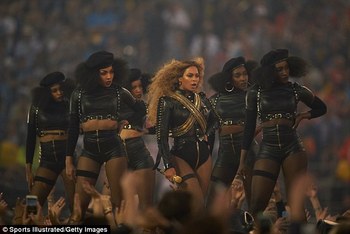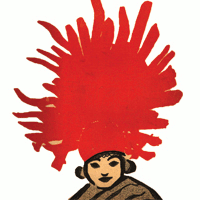Peer-Reviewed Exhibits content in SiRO is protected by a Creative Commons License.
Contextualizing Beyonce's "Formation" and Black Panther Imagery
8
Super Bowl 50, February 7, 2016
Produced by Nathan Leaman

|
The Super Bowl 50 halftime show consisted of musical performances by Coldplay, Bruno Mars and Beyonce. During Beyonce's portion of the program, backup dancers wore black berets and shiny leather jackets adorned with what looked like ammunition belts slung across their shoulders. These dance costumes appeared to appropriate the imagery of the Black Panter Party, a black nationalist group operating from 1966-1982.
Beyonce's performance can be viewed by following this link. Formation Halftime Show. Many viewed this appropriation of Black Panther Party imagery as a response to heightened media attention to police violence against black people of the past few years. ___ |

|
Many political pundits feared that this performance, and the dancers' costumes in particular, constituted a radical call for violence against police.
One of these pundits, Tomi Lahren describes the Black Panther Party as "a group that used violence and intimidation to advance not racial equality but an overthrow of white domination. The Black Panthers, for those of you that don't know, were critical of Martin Luther King's nonviolent civil rights movement. They didn't believe in change through peace; they promoted violence instead." This view of the Black Panthers as a group that overtly promotes violence is not new. Black Panther Party members have been represented as violent in American culture since the early 1970s, particularly after the party was targeted by the FBI who deployed a Counterintelligence Program, a systematic campaign meant to "expose, disrupt, misdirect or otherwise neutralize" the party. Certainly, individual members of the party were involved in violent events but was the Black Panther Party itself violent? This exhibit was created to investigate this question and to test that cultural represent by looking to primary historical documents, produced by the Black Panther Party itself to determine the party's relationship with violence. |
Contextualizing the Black Panther Party, 1966-1982
|
This document, created by the John Brown Society and amended by the Radical Education Project, is useful in this project because it uses the Black Panther Party's own words to provide an introduction to the party's stated beliefs. It also includes a detailed history of the party's emergence and early leaders such as Huey P. Newton and Bobby Seale. This document lays out the ideology of the party, explicitly listing the political desires and accompanying beliefs and rationals for those desires. These desires include things like self-determination, the cessation of police brutality, access to adequate housing options, and full employment. |
|
This document was created to inform a broad audience about the political platform and goals of the Black
Panther Party. The goals described here are in line with those mentioned in "What do the Black Panthers Stand For," however, this document also describes concrete actions performed by the party to meet these goals.
These actions include the teaching of community education classes, the administration of free health clinics, free meals, and political organization and legislative advocacy for full employment and decent housing. These actions are meant to benefit poor black communities. |
|
This text collects together various writings by Huey P. Newton, co-founder of the Black Panther Party. There is also an introduction written by a later leader of the party, Eldridge Cleaver.
One of the most important themes of this Newton's writings is the call for black nationalism. Newton believed that the solution to the racial oppression of America's past and present is that black Americans be empowered with self-governance. |
|
Conclusion and Further Study
After researching the documents listed in this exhibit, I found no calls for members to provoke violent altercations with police. Violence is discussed at multiple points but the party only sanctions the use of physical force against another person if it serves the purpose of self-defense, a principle also sanctioned by the U.S. government. History tells us that violent altercations between the Black Panther Party and the police certainly occurred and party members have been found guilty of murder, but to claim that these actions are endorsed by the party as defined by their own writings, is false. After coming to this conclusion, I would go on to argue that this rhetoric is dangerous because it treats all black Americans as a monolith and it perpetuates the harmful stereotype that suggests black Americans are inherently violent and dangerous. This stereotype is not new; its history can be observed in many images and historical documents dating back to the moment the first slaves brought to the North America. Though I would imagine that few political pundits consider themselves racists (indeed, Tomi Lahren has claimed repeatedly that she is not), stereotypes work through socially conditioning, can manifest at subtle moments, but can support devastating evil. This stereotype in particular has been employed to legitimize the torture of slaves in the nineteenth century, lynchings in the twentieth century, and racial profiling in the twenty-first century. |

|





